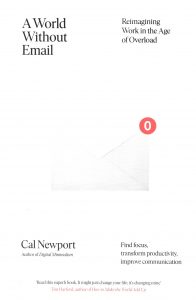The one sentence summary
Find focus, transform productivity and improve communication by reimagining work in the age of overload.
Can’t be bothered to read it? Too much screen time lately? Listen to the 5-minute podcast.
WHAT THE BOOK SAYS 
- Email reduces productivity, makes us miserable and has a mind of its own, so let’s get rid of it.
- In 2019 the average worker was sending and receiving 126 business emails a day – about one every four minutes.
- The Hyperactive Hive Mind is a workflow centred around ongoing conversation fuelled by unstructured messages delivered through digital communication tools like email and instant messenger services.
- Constant interruptions have a switching cost and leave attention residue, making it harder to concentrate on the next thing. The best workflows minimize mid-task context switches and minimize the sense of communication overload.
- The Attention Capital Principle states that the productivity of the knowledge sector can be significantly increased if we identify workflows that better optimize the human brain’s ability to sustainably add value to information.
- The Process Principle states that introducing smart production processes to knowledge work can dramatically increase performance and make the work less draining.
- The Protocol Principle states that designing rules that optimize when and how coordination occurs in the workplace is a pain in the short term but can result in significantly more productive operation in the long term.
- The Specialization Principle states that in the knowledge sector, working on fewer things, but doing each thing with more quality and accountability, can be the foundation for significantly more productivity.
WHAT’S GOOD ABOUT IT
- In a cycle of responsiveness, people learn that you are available at certain times, you respond, they send more, and the process intensifies. Unwittingly, this becomes collaborative pacing, and the best way to break it is to make sure that your email system does not send your out of hours messages until the following morning.
- PTO is predictable time off. This is where team members are given set times when they can completely disconnect from email to get on with proper deep work.
- Energy-minimizing email ping-pong describes the tortuous to and fro involved in arranging a meeting and there is a high cognitive and time cost.
- Do less, do better; sprint, don’t wander.
- Two helpful work reduction strategies: outsource what you don’t do well, and trade accountability for autonomy (work uninterrupted, but definitely deliver on time and in full). Deliver what you promise but don’t explain your regime.
- Whereas email dictates your day, workboards such as Trello allow the person to choose their interaction with projects and tasks.
WHAT YOU HAVE TO WATCH
- The book starts strongly but it is not as radical as claimed, and by the end drifts off into some fairly old-fashioned techniques involving progress charts and Kanban boards.
